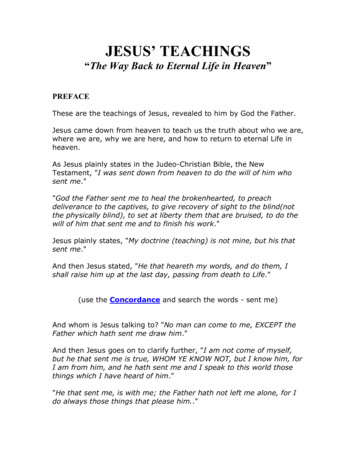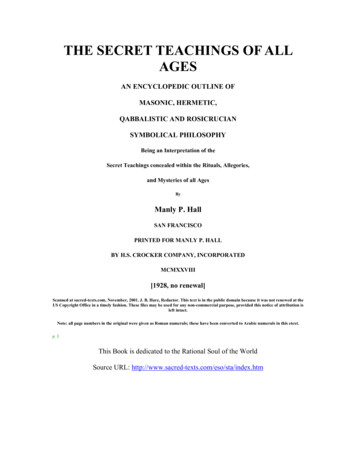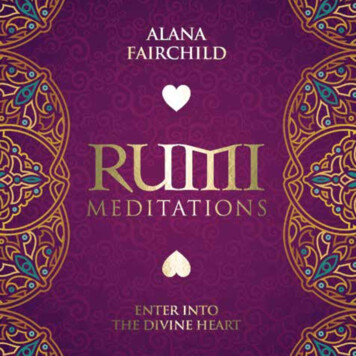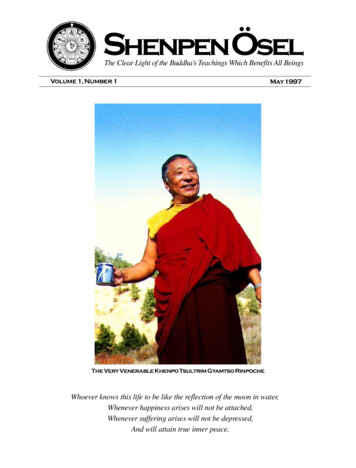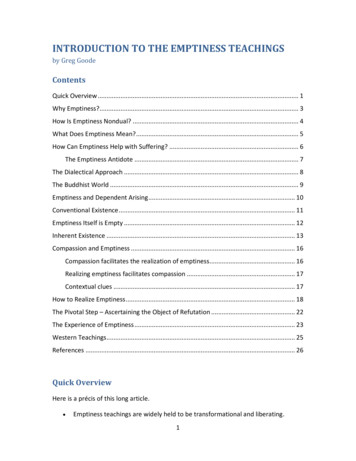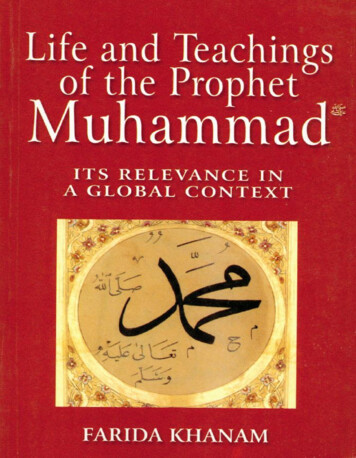
Transcription
Life and Teachings of the Prophet MuhammadTable of ContentsTABLE OF CONTENTSTable of Contents.2Introduction .51. Arabia before Islam.7Makkah .8The Characteristics of the Arab People .142. The Life of the Prophet Muhammad .18Opposition Intensified.32Islam spreads to Yathrib (Madinah) .37The Prophet Arrives at Madinah.40Brotherhood of Islam .41The Prophet’s Mosque.42The Prophet’s Family .43Jihad.44The Battle of Badr .44The Battle of the Trench .46Treaty of Hudaybiyyah .47 2
Life and Teachings of the Prophet MuhammadTable of ContentsCall to the World.48Fall of Makkah .49Pardon for All.50Battle of Hunayn.50First Hajj under Islam.51The Farewell Pilgrimage .523. The Concept of Worship in Islam.54The Implication of worship.56Five Pillars of Islam .58The Spirit of Faith .59The Spirit of Salah.60The Spirit of Fasting .60The Spirit of Zakah.61The Spirit of Hajj .624. The Concept of the State in Islam.645. The Status of Woman in Islam.75Hijab in Islam.786. War and Peace in Islam .83 3
Life and Teachings of the Prophet MuhammadTable of Contents7. The Importance of Education in Islam .91Merit of the learned and learners.92The Development of Natural Sciences.958. The Concept of Ijtihaad in Islam.1029. Human Rights in Islam .116Some Comparative Examples.1201. Freedom of religion: .1202. Justice and equality before the Law:.1213. Freedom of expression and dissent: .12310. The Concept of Social Welfare in Islam.12611. The Concept of Spirituality in Islam .13712. The Relevance of the Quran and Sunnah in ModernTimes.150 4
Life and Teachings of the Prophet MuhammadIntroductionINTRODUCTIONBOOKS on Seerah (Life of the Prophet) exist in great numbers.These are no doubt valuable books in their own right. However,one aspect of Seerah still remains to be highlighted. And that is,the relevance of seerah in the modern world. It is a subject, which,despite its great importance, has yet to be treated with sufficientthoroughness.The books written on the subject of seerah give extensivecoverage to miracles, wars and victories. Emphasis on thesematters appeals to the conventional mind, but it has no appeal formodern man. These things do not address his mind. The modernman thinks in terms of science and not in terms of miracles. Hethinks in terms of peace and not in terms of war. He is moreinterested in solutions to human, social and economic problems,rather than descriptions of political and military conquests. A thingbecomes understandable to the modern man only when it ispresented within the framework of reason rather than beliefs.I have planned my book keeping in view this most urgent,present day requirement. I want to present a book, which is notjust a repetition of the books already written, but one whose aimwould be to fulfill modern intellectual requirements, focusing onthe relevance of the Prophet of Islam in contemporary globalcontext. 5
Life and Teachings of the Prophet MuhammadIntroductionAnother important thing, which is lacking in most of the booksof Seerah is that they do not underscore the peaceful methodfollowed by the Prophet.A deep study of Seerah tells us that the Prophet invariablyadopted the peaceful method unilaterally. He thus succeeded inbringing about a bloodless revolution in Arabia. Unfortunately, thisaspect of Seerah has not been highlighted in existing biographies ofthe Prophet.In present times, owing to certain global concerns, thepropensity to study Islam has greatly increased. All over the world,curiosity has been aroused as to what exactly is meant by Islam.What is urgently needed, therefore, is an objective, in-depthstudy of Islam—one which presents Islam as it actually is,uncompromisingly and without bias. It is in order to meet thisneed—in particular, to show how Islam can meet the challenge ofviolence—that I have undertaken the venture of presenting Islamas it is in the light of Prophet’s life and teachings.Farida Khanam 6
Life and Teachings of the Prophet Muhammad1. Arabia before Islam1. ARABIA BEFORE ISLAMWITH an area of 1,20,000 square miles the land of Arabia is thelargest peninsula in the world. It has the Red Sea to the West, theArabian Sea and the Gulf of Adan to the south-east and the riversEuphrates and Tigris and the Persian Gulf to the north-east. It thusoccupies a unique position. It is situated in Asia, yet only thenarrow Red Sea divides it from Africa and by just passing throughthe Suez Canal, one reaches the Mediterranean Sea and Europe. Itis thus at the centre of three continents, yet it is apart from all ofthem.Arabia being a very hot and dry country, one third of it isdesert. It is strange that a land surrounded by water on three sides,and with only a narrow strip of land to the north, has practically noriver of its own, except for small streams here and there, whichsoon dry up in the hot desert.Rain too is scarce. The rains come in torrents in spring, but thewater does not stay. It is lost in the sand as quickly as it comes.There being no dependable rainy reason, which is necessary foragriculture, this vast land, about a thousand kilometres wide andabout the same in length, is neither fertile nor cultivable.Yemen, the original home of the Semites, is the only exception,in that it is fertile and enjoys a rainy season. Besides this, the restof the peninsula consists of barren valleys and deserts. Due to thelack of vegetation, life here can be only that of the desert. The 7
Life and Teachings of the Prophet Muhammad1. Arabia before Islamcamel, the only means of transportation is indispensable, for adesert life demands continuous movement. The desert dwellersmust continually go in search of pastures, which are scarce andthin, and soon cropped bare. The pastures turn green aroundspring, watered by springs which form in the wake of occasionalrainfalls. In such an infertile country where no agriculture has everbeen possible, the only produce is dates. In the context of thiscivilization, Yemen has always been very developed in terms ofagriculture. Showing great intelligence the Yemenis invented waysof saving rain water from running down to the sea so that artificialirrigation could be carried out. Moreover, they built the famousdam of Maarib by changing the natural course of the water. Thiswater is gathered in a 400 meter wide valley between twomountains by constructing a dam with gates at the narrowest pointin the valley.Then this water is divided into many streams and spread over awide area of plains. It is almost like the Nile in the dam area inUpper Egypt. In this way they have contrived to have a controlleddistribution of their water. The fertility of their land has gone onincreasing and the people of Yemen have become very prosperous.MAKKAHWhen Hajira’s infant son started crying for water she randesperately between the hills of Safa and Marwah in search ofwater. She ran seven times when finally she discovered a spring ofwater gushing from the ground by the side of her son. It was this 8
Life and Teachings of the Prophet Muhammad1. Arabia before Islamspring which is known as Zamzam. Makkah is founded at thisspring spot of Zamzam.Both Makkah and Madinah were, and still are, islands in a seaof desert. These towns were initially inhabited by the descendantsof the nomads, who still retained many of the desert born habits oftheir ancestors.Situated in a valley, Makkah is one of the oldest cities in theworld. It is a desert, with no vegetation, no date-palms.There are some fertile spots in the desert, which are calledoases. There are also springs of water here and there, althoughgrass and palm trees grow. These springs of water are scattered allover the desert. Large as well as small clans settle around theoases.Makkah since ancient times was an important centre for thecaravans coming from the south with valuable merchandise. Theybrought gold, precious stones and spices from Africa to Yemen.From here it was taken to the markets of Syria, Egypt and manyother places on the backs of camels.The merchants travelled in caravans for the sake of safety. Forin those days caravans were an easy target. Since these caravanspassed through vast stretches of uninhabited deserts, it was easyfor plunderers to rob them of all their merchandise.At Makkah agriculture not being possible, the city thrived oncommerce. Makkah became an important trading centre because of 9
Life and Teachings of the Prophet Muhammad1. Arabia before Islamthe Sanctuary – the Kabah, to visit which people came from placesfar and near. Its geographical position was very good from thepoint of view of trade, it being situated at the crossroads of theroutes from Yemen to Syria and Abyssinia to Arabia. So thenomads came to Makkah from all sides. By the 6th century, Arabtraders had become very influential and controlled the trade fromYemen to Syria. Taif was also an important commercial centre butMakkah was more important because of the Kabah.So Makkah became a religious as well as a financial centre. Bythe time the Prophet conquered Makkah, we find many influentialtraders who were adept at doing business with different parts of theworld. Although Yemen was the most advanced province in theArabian Peninsula because of its water resources and soundadministration, Makkah being a religious centre wielded greaterinfluence on this account. Makkah, a focal point of pilgrimagedating back to the origin of Arab history, owed its status to theKabah, which had been built by Ibrahim and Ismail.Everyone observed its holy months for religious reasons as wellas on account of the special position it enjoyed with regard totrade, being the capital of the peninsula.The Arabs of the North are considered Arab al mustaribah,“Arabized Arabs.” The Qahtanis of the South are considered Arabal Mutaarribah, or tribes resulting from mixing with the Arab alAribah, original, or true Arabs. From the Qahtanis descend theArabs of ancient South Arabia, or “Himyarite” Kingdoms. Thecompletely “true Arabs”, descendants of Aram, son of Shem, son 10
Life and Teachings of the Prophet Muhammad1. Arabia before Islamof Noah, are called the Arab al baidah, “the lost Arabs”, theiridentity having been submerged in that of other peoples.The progeny of Ismail were known as Mustariba, or naturalisedArabs, and they greatly multiplied. They were divided into manytribes and clans. The Quraysh, the largest tribe, descending fromthe Kinanah and Ismail, had several clans. They were settled inMakkah by an ancestor of renown called Qusayy, who displaced theprevious inhabitants, the Khuzaah. The clans who lived in thevicinity of the Kabah were considered most honourable. Thesewere called Quraysh al Bitah (the Quraysh of the Hollow).The location of Makkah on important caravan routes across thePeninsula, and the prestige of the Kabah in the age of Ignorance(Jahiliyyah) gave it great advantages as a trading city. This is whythe Quraysh became one of the richest and most powerful tribes.This, together with their descent from the Kinanah and Ismail, gavethem claims to an aristocratic pre-eminence.The Prophet Muhammad was of the Banu Hashim clan of theQuraysh, who lived in the vicinity of the Kabah and enjoyed greathonour and prestige in Arabia. These clans were divided intofamilies. Besides these Arabs there were also Christian and Jewswho lived in Arabia. A large number of their population lived inMadinah.In Arabia there are two different geographical types of soilmarkedly different from one another – the oasis and the desert.The inhabitants of Arabia naturally fall into two main groups:nomadic and settled people. The city dwellers settled in one place 11
Life and Teachings of the Prophet Muhammad1. Arabia before Islamand lived on cultivation because they knew how to till the land andgrow corn. They engaged in commerce not only within their owncountry, but also abroad. But the Bedouins, being nomads, dislikedthe idea of a settled life and wandered from place to place withtheir families and belongings. Prof. Hitti in his book the History ofthe Arabs, writes: “The Bedouin is no gypsy roaming aimlessly forthe sake of roaming. He represents the best adaptation of humanlife to desert conditions.” (p. 23)They lived in tents and possessed goats, camels and horses.They were continually on the move in search of pastures and whenthey halted temporarily they lived in tents or camps. They engagedfor economic reasons in horse-breeding, hunting, camel raising,etc. They thought that these were the only occupations worthy of aman. They disliked agriculture, trade and commerce. In the desertthe basic unit of life is not the state but the tribe. The Bedouinsattach the greatest importance to total freedom for the individualas well as the tribe, but this was not the case with the city-dwellers.They attached importance not only to freedom but also to peace,security and prosperity. Another feature of tribal life, is the belief inabsolute equality. All the members of the tribe are treated equally.This is because of the influence of the desert, with the freedom ofits vast limitless expanses. If they had any injustice forced uponthem, which they could not bear or confront, they left behind theirpasture and moved on to another place where there would be noinjustice—only freedom and equality. In times of conflict, theydepended upon the sword. It was considered as a pre-requisite forthe individual to be able to defend himself and his tribe. 12
Life and Teachings of the Prophet Muhammad1. Arabia before IslamThe nomadic life is based upon stockbreeding, especially thebreeding of camels. There is some rain in the winter season andthen some vegetation comes up in the low-lying areas. These areasbecome a paradise for camels, as they provide the best pasture,but with the coming of summer the pasture vanishes. Then thenomads move on in search of other green areas in order to feedthemselves as well as their camels. Then there are some wells,which provide water for the camels. The milk of the camels is thediet of the nomads along with dates, which are obtained from theoases. Cereals are not easily available. Only the rich can affordthem. The oases that are found in Madinah are near themountains. So there the date crop is grown. And in Taif, which hasvery fertile soil, cereals are grown. Madinah has the largest of theoases.Ibrahim was the first to teach them the worship of one God.The Arabs followed the religion of Ibrahim for some generations,but their later generations tended to deviate from the straight pathshown to them by Ibrahim and became idolators. At the time of thebirth of the Prophet, the whole of Arabia had taken to idolatry.Some of the tribes worshipped stars and planets, some stone idols,and, thus the Kabah, which had been built for the worship of Godbecame a centre of idolatry. It housed 360 idols, one for each dayof the year. Hubal was the most honoured. Carved in red stone, itheld seven arrows in its hand. Among the Arabs lots were drawn todecide all important matters. 13
Life and Teachings of the Prophet Muhammad1. Arabia before IslamThe Quraysh were the most influential tribe in Makkah. Most ofthem were engaged in trade, and some of them were great traders.The name Quraysh is derived from a word which means to trade.Since the Quraysh was the largest and most powerful tribe inMakkah, its chief was the most influential man in Makkah.THE CHARACTERISTICS OF THE ARABPEOPLEIslam emerged in a region known as Hijaz, inhabited by thedescendants of Ismael and Banu Kinanah. These people had accessonly to limited resources, limited habitable area, cattle, pasture andoases. Everything was in short supply. So they could afford to leadan extremely simple life.Due to these constraints they often waged war, sometimes totake possession of the limited reservoirs of water and pastures.Nevertheless, these Bedouins had noble human qualities. For theylived very far from the artificial world of civilization. Theatmosphere of nature served as a vast school of nature for them.They never led the artificial life of the cities and their life wasdevoid of all formalities. This extremely simple, austere life madethem realists.All this was responsible for producing in them the qualitieswhich the Arabs call al muruuwah, manliness, which meant to themacknowledging the truth, speaking nothing but the truth, fulfillingpromises, honouring obligations, supporting the oppressed, 14
Life and Teachings of the Prophet Muhammad1. Arabia before Islamboldness, noble character, patience, generosity and hospitality.When this high level of humanity was combined with the truth ofIslam, they were enabled to perform great feats. It was this truthwhich has been thus expressed in a hadith:“Those who were good people in the days ofignorance will also be good people during Islam.”In ancient Arabia despite their battles, wars, conflicts andtensions, their vows of revenge, which went on for generation aftergeneration, their mentality, their thinking, their aptitude foracknowledging the truth were fully preserved.For instance, once in ancient Makkah two groups: were readyto fight. At this juncture, Abu Sufyan ibn Harb intervened and saidto them: “If you waged a war so many people would be killedbelonging to both the groups. So should I not tell you somethingbetter?” They agreed with him. Then Abu Sufyan said: “What haspassed has passed, now you must make peace.” Both the partiesaccepted his advice there and then and made peace. This was inspite of the fact that there were people who used to go on fightingfor as long even as 50 years to avenge a murder or an insult or anyinjustice done to them.Due to the paucity of economic resources, there were peoplewho indulged in looting. But even these people were of a noblecharacter. Once a Bedouin wanted to robe a woman who was allalone in her tent decked with jewellery. But he did not enter the 15
Life and Teachings of the Prophet Muhammad1. Arabia before Islamtent. He stood at the door and commanded her to take off all herjewellery and hand it over to him.While the woman was taking off her jewellery, the man stood atthe door with his back towards it, so that he did not catch sight ofthe woman while she was taking off her jewellery.These Arabs had not been idol worshippers since ancienttimes. Idolatry was only a later introduction into their lives throughforeign influence. The idols were imported into Arabia. So therewas no ideology behind this idol worship. It was thus of asuperficial nature, having no deep ideological or philosophicalroot. For instance, once an Arab wanted to take revenge for hisfather. So he went to an idol called Dhul Khalasa for diviningarrows. But the answer that came from the idol was not in theaffirmative. This enraged the Arab and, addressing the idol, heuttered these words: O Dhul Khalasa, had your father been killedyou would never have uttered this falsehood that the oppressorshould not be punished.”Similarly, another Arab led his camels to his idol Sad in orderto seek its blessing. It was a tall idol, and was covered in blood dueto the sacrifices made to it. On seeing this sight, the camels werefrightened and ran away. When the Arab saw the flight of hiscamels, he hit the idol with a stone, abusing him:“May God destroy you. I had come to seek yourblessings and you made my camels run away.” 16
Life and Teachings of the Prophet Muhammad1. Arabia before IslamOf these ancient Arabs there were a sizeable number who wereknown as Hanif. These people were truth seekers and they shunnedidolatry. They lived an aloof, social life. They used to say:“O, God, I do not know how You should beworshipped. Had I known, I would have certainlyworshipped you in that manner.”These circumstances of the ancient Arabs and their moralqualities had a close affinity with Islam. These people true innature, were as if potential converts of Islam. Therefore when theProphet of Islam began his preaching in 610, these Hanifs took notime in responding to his call and became his devoted companions,Abu Bakr ibn Abi Qahafa being one of those Hunafa. Whatdistinguished the Arabs from others was that they could not affordto reject a truth when it had become clear to them. That is why inthe initial stage of the Prophet’s call, due to somemisunderstanding, a number of them turned against the ProphetMuhammad. But when finally they learned that what the Prophetwas telling them was nothing but the truth, they took no time inentering the fold of Islam. There are a number of incidents in thebooks of Seerah to this effect.Thus the sending of the Final Prophet was not without reason.It was a well-planned decision of God which He in His Ownknowledge decreed. These Arabs were the living people who wereselected by God to lend full support to His final Prophet, so thathe might fulfill the divine mission. 17
Life and Teachings of the Prophet Muhammad2. The Life of the Prophet Muhammad2. THE LIFE OF THE PROPHETMUHAMMADTHE Prophet of Islam, Muhammad ibn Abdullah, was born inMakkah in 570 A.D. in the tribe of Quraysh and died at the age of63 in 632 A.D. in Madinah. The year of his birth is known amongthe Arabs as the year of the Elephant (Aam al-Fil) referring to thecampaign of Abraham, an Abyssinian ruler, who had come toMakkah to destroy Kabah. Makkah was then inhabited mainly by thetribe of Quraysh. In those times, this tribe enjoyed great prestige allover Arabia and the neighbouring countries, for Makkah was aflourishing trade and religious centre.Muhammad was still in his mother’s womb when his father,Abdullah, died. After his birth, Amine, his mother, sent the baby toAbdul Mutely, his grandfather, who was in Kabah at that time. Thegrandfather was overjoyed at the news, for he loved Abdullah,Muhammad’s father, very much. The grandfather gave him thename “Muhammad”, meaning “the praised one.” As was thepractice of the Makkah nobility, he was handed over to a wetnurse, Kalimah al-Sadly, who belonged to the Banu Sad tribe. Thiscustom is still practiced among Makkah aristocracy.Kalimah nursed Muhammad for two years and a few months.She said that when he stayed with them, her family received allkinds of unaccustomed blessings. Having nursed so many childrenbefore, she noticed something ‘different’ or ‘extraordinary’ about 18
Life and Teachings of the Prophet Muhammad2. The Life of the Prophet Muhammadthe infant Muhammad. These observations are recorded in detailby some biographers such as Al-Walid, Ibn Ishaq and Ibn Hisham.Two years later, after the child had been weaned, Kalimahbrought him back to his mother. But Makkah at that time wasstricken with an epidemic, so Amine asked her to take him back tolive in the pure air of the desert.Thus Muhammad remained in the charge of Kalimah until theage of five. He learned Arabic in its purest form from this tribe.Muhammad used to tell his companions, “I am the most Arabamong you, for I am of the tribe of Quraysh and I have beenbrought up among the tribe of Banu Sad bin Bakr.Muhammad returned to his mother after five years of desertlife. Then Amine took him to Madinah to meet her uncles, theBanu al-Ajar. She was accompanied by Umm Layman, her servant,on that trip. After a stay of a month in Bathrobe, Amine was on herway back to Makkah, when passing through a village called Abash,she fell ill and died there. She was buried in Abash. It fell to UmmLayman to bring Muhammad back to Makkah.Therefore, the orphan Muhammad was taken care of by hisgrandfather Abdul Mutely, chief of the clan of Banu Hashim. Helooked after him with great affection. As leader of the Quraysh, heused to sit on a cushion in Kabah, whenever Muhammad joinedhim, he was allowed to sit on that cushion. If anyone tried to stophim, his grandfather would say, “Leave him alone. By God, he isvery important.” (Ibn Hisham) Abdul Mutely died whenMuhammad was eight years old. 19
Life and Teachings of the Prophet Muhammad2. The Life of the Prophet MuhammadNow the guardianship of Muhammad passed to Abu Talib, hisuncle, who was a merchant. Once when Abu Talib was preparingto go to Syria on a trading journey, Muhammad expressed a keendesire to accompany him. Though he was very young to undertakesuch a difficult journey, Abu Talib was so full of affection for himthat he could not refuse, and agreed to take him on the journey.Their trade caravan halted in the city of Bursa in Syria. Therewas a Christian monk by the name of Bah rah living there in amonastery. He had read in the ancient books about the emergenceof an Arab prophet. He recognised in Muhammad the signs ofprophethood. He knew at once that he was the boy who had beendestined to become the last of the prophets.The monk invited the whole caravan to his monastery andasked Abu Talib, “In what way are you related to this child?” Hesaid, “He is my son.” Bah rah said, “It cannot be. His father shouldnot be alive.” Then Abu Talib informed him that his father was nolonger alive. Bah rah advised him to return with his nephewimmediately and to protect him from enemies. He said, “By God, ifhe is recognised, he will surely be harmed.”Ibn Ishaq writes, “Muhammad entered his adulthood as if GodHimself was protecting him from the widespread evils of the periodof ignorance.” By this time he was well-known in Makkah for hisgood morals, gentle disposition and sincerity. In fact, he was calledAl-Amin (trustworthy) and As-Sadiq (truthful) by his compatriots. 20
Life and Teachings of the Prophet Muhammad2. The Life of the Prophet MuhammadWhen Muhammad was twenty-five, a rich 40-year old widow,Khadijah bent Khuwaylid of the Quraysh tribe, entrusted him withthe management of her business. She used to employ men toengage in trading on her behalf, and rewarded them with a share ofthe profits. Muhammad was so honest in all his dealings that shewas deeply impressed by his virtues and expressed her desire tomarry him. After consultations with his uncle, Muhammadaccepted the proposal of marriage. Khadijah became his first wifeand during her lifetime he had no other wife. With the exception ofIbrahim, who died in infancy, all his children were born toKhadijah. All his sons died in infancy. Of the daughters, Ruqaiyyah,Zaynab, Umm Kulthum and Fatimah lived long enough to acceptIslam and migrate to Madinah with the Prophet.When Muhammad was twenty-five, the Quraysh decided torebuild the Kabah after a sudden flood had shaken its foundationsand cracked its walls. The old structure was demolished and thenew construction began. When the walls rose from the ground andthe time came to place the famous Black Stone (Hajr al-Aswad) inits place on the east wall, a dispute arose among the clans as towho would have the honour of laying it in place. Each clan wantedto have the honour of placing the stone for itself. This disputealmost led to a civil war. No peaceful solution seemed possible.At this critical juncture Abu Umayyah, son of Mughirah alMakhzumi said to the Makkans, “Put it off till tomorrow, the manwho enters the Kabah first of all in the morning will be ourarbitrator in this dispute.” Everybody liked the idea. Men from 21
Life and Teachings of the Prophet Muhammad2. The Life of the Prophet Muhammaddifferent tribes ran to the Kabah before dawn next morning. Eachone tried to be the first to enter the House of God. But the firstone to pass through the gate was Muhammad. On seeing him theyall said, “There goes al-Amin. We shall agree with his verdict.”Then he was asked to give his decision on the matter. He took asheet of cloth and spread it on the ground, and placed the BlackStone in the middle of it and then he asked the chiefs of all tribesto hold different ends of t
Life and Teachings of the Prophet Muhammad 1. Arabia before Islam 7 1. ARABIA BEFORE ISLAM WITH an area of 1,20,000 square miles the land of Arabia is the largest pe


